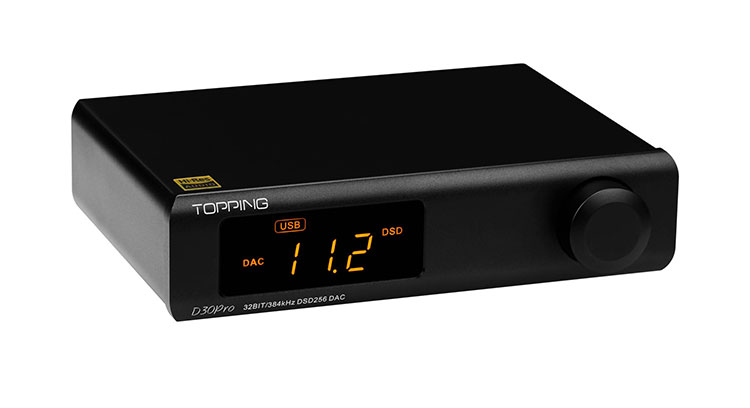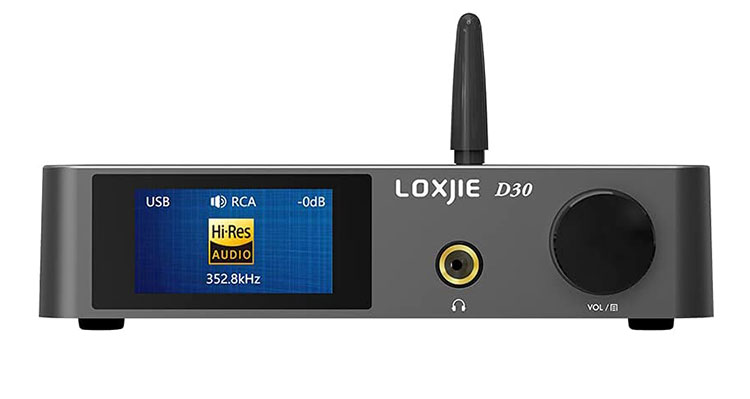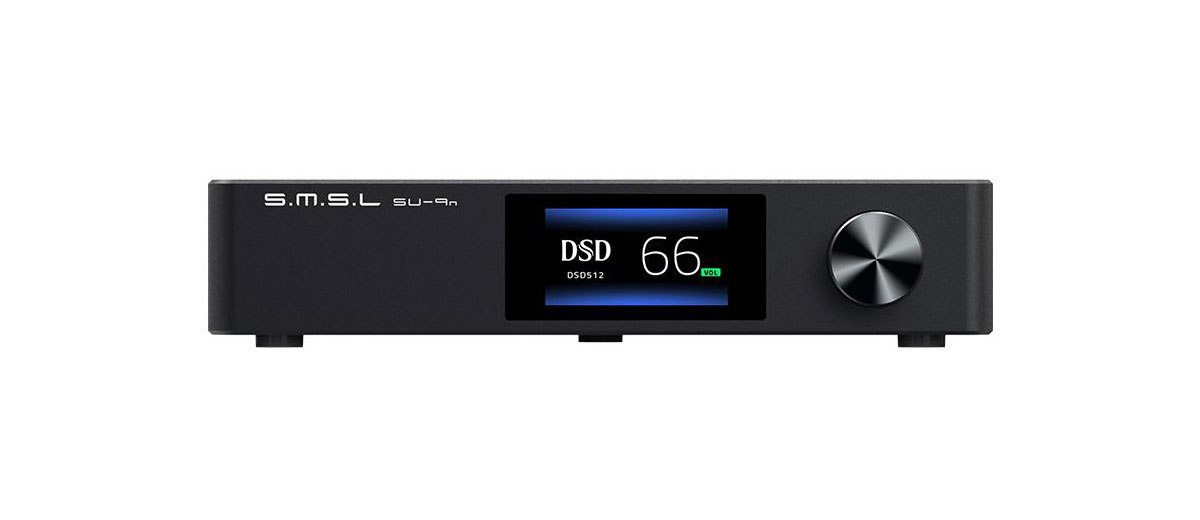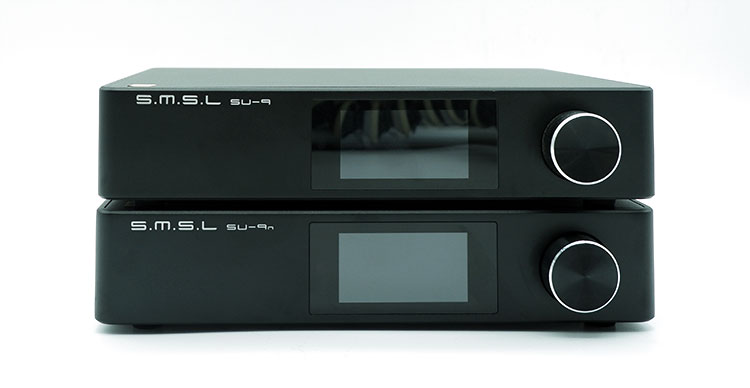Select Comparisons
SMSL SU-9
$439.00
Technical
With the model number only differing by 1 letter, I was expecting them to have a lot of similarities. And true enough, they share some internal components including the ESS9038Pro DAC chip which allows both DACs to decode 32bit/768kHz PCM and DSD512. However, the more advanced XMOS XU216 USB controller on the SU-9 allows it to decode MQA streams.
The built-in Bluetooth chips on the 2 devices are also different since the one on the SU-9 allows it to work with the UAT codec. However, the UAT codec is still not as ubiquitous as LDAC, and ApTX/HD so both DACs are still compatible with the more mainstream Bluetooth codecs.
One notable difference between the 2 DACs though is that the original SU-9 isn’t specified to have the ES9311 power supply chip. This translates to the SU-9 having a higher noise floor with a higher THD+N of 0.00006%.
Design
While the internals of the 2 DACs is not exactly the same, the 2 DACs are much harder to distinguish physically. The layout of the front and the rear of both devices has the same digital input options and either a single-ended RCA output or a balanced XLR output.
Turning on the 2 DACs and looking at them side by side, the screen brightness of the original SU-9 is dimmer. In the menu options, the 2 DACs also have a similar set of options, except that the original SU-9 doesn’t have a dimmer function that dims the screen automatically after a certain amount of time.
The biggest update on the SU-9n is the remote control. Although the remote controls on both DACs are interchangeable, the updated remote has better range and accuracy while losing out on the universal remote functionality of the remote from the original SU-9.
Performance
When listening to the 2 DACs, it’s obvious that the 2 DACs have a lot in common, and I’m not too surprised because SMSL has been successful with the SU-9. With the specs sheet on the SU-9 indicating that it has a higher noise floor, I was expecting to hear some audible difference between the way that the 2 DACs present quiet passages, but that’s not how it works.
So both DACs keep that generally neutral tonal balance while having more weight behind each note. This allows both DACs to present an impactful bass line while having a euphonic and rich midrange presentation.
However, the biggest difference that I heard between the 2 DACs is that the original SU-9’s bassline is comparatively less textured. So this means that the hollowness of drums isn’t as pronounced with the SU-9. Similarly, the nuance in the vocal presentation couldn’t be picked out as easily so the raspy vocals of Adele are more smoothed over with the SU-9.
The soundstage presentation is equally wide, while the placement of images both in terms of width and depth is equally accurate. However, the images are just a bit more blended together with the original SU-9.

Topping D30 Pro
$399.00
Technical
Instead of going with ESS-based DAC chips, the D30 Pro opted to have 4x CS43198 DAC chips from Cirrus Logic to create a fully balanced circuit. This is then fed by an XMOS XU208, a USB controller chip that is featured on both DACs.
However, the decoding capabilities on the D30 Pro just top out at 32bit/384kHz PCM and DSD 256, but these resolutions are still capable of decoding most files available today.
Both DACs have a similar set of input and output options, where they have USB, Coaxial, and Optical, while also having both RCA single-ended and dual-XLR balanced outputs. However, the D30 Pro omits Bluetooth connections altogether limiting the D30 Pro to wired operation only.
The D30 Pro has a slightly lower THD+N of 0.00009% and a slightly higher dynamic range of 132dB. Since these numbers are pretty close, it would be interesting to see how they translate to the sonic differences between the 2 DACs.
Design
At first glance, the D30 Pro is a more retro-looking DAC, mainly because of the 7-segment displays in front. However, the 2 DACs have a very similar construction since both have an aluminum chassis while having a volume knob that’s also used for menu navigation. Furthermore, the arrangement of the inputs and outputs at the rear of the D30 Pro are similarly arranged so neither ends up too crowded.
The menu system on the D30 Pro is a bit more difficult to navigate since it doesn’t have words, instead, the different options are represented by codes. Also, the menu options on the D30 Pro are more difficult to access since some menu options can only be accessed while the device is powering up or with the use of the provided remote control.
When it comes to desk space, the D30 takes up a bit less since it’s about ½” narrower and ½” more shallow.
Performance
Both have a generally neutral tonal balance, but the D30 Pro has a more energetic presentation compared to the SMSL SU-9n.
When it comes to the bass, both DACs extend well into the sub-bass, but the sub-bass quality is more environmental on the D30 Pro. Going into the mid-bass, the 2 DACs produce an equal amount of mid-bass presence, however, the D30 is drier, and thinner but more textured while slightly losing out on control.
The vocal presentation, on the other hand, is more recessed with the D30 Pro, this typically forces me to increase the volume a bit more particularly when listening to vocal-centric tracks. Between the 2 DACs, the D30 Pro’s drier presentation makes the vocal presentation less euphonic, and more matter of fact.
Similarly, instruments are presented with a crisper quality to instruments such as guitars that are being plucked. Pianos on the other hand have a brighter tilt on the D30 Pro comparatively, giving a more percussive quality allowing successive keystrokes to be more distinct. However, more flowy passages on the D30 Pro sound less connected.
Going into the treble frequencies, it’s a very similar story where the D30 Pro has a crisper presentation. This allows leading edges of notes to be easier to discern, making cymbal hits much more energetic.
When listening to orchestral recordings, both DACs have a spacious soundstage giving the orchestra a good sense of space. Imaging on the 2 DACs is quite different though, where the D30 Pro has a slightly more dispersed but more defined imaging presentation, while the SU-9n gives a better sense of scale while having a more accurate placement of images within the soundscape.

Loxjie D30
$259.99
Technical
Examining the specs sheet on the 2 DACs, it’s clear that the D30 is a step behind in terms of the DAC chip used. However, both DACs have chips that come from ESS with the D30 using an ES9068AS chip instead of the flagship ES9038Pro DAC chip. Although both DACs are configured to decode 32/768kHz PCM and DSD512, the D30 can also decode MQA files.
Looking at the measurements of the 2 DACs, it’s immediately apparent that the D30 is a step behind due to the lack of balanced outputs. This results in the D30 having a slightly lower measured value of THD+N at 0.0001%. The measured dynamic range on the D30 is also 7dB lower at 123dB.
In terms of the available inputs, both DACs have a similar selection, allowing for USB, coaxial, optical, and Bluetooth. However, the output options on the D30 are a bit different since it has a single-ended RCA pre-out and a headphone output instead of having a balanced output option.
Design
With the absence of a balanced connection, the D30 doesn’t need much space at the rear thus making it 1” narrower, but about ½” deeper. So both DACs take up about the same amount of desk space. The chassis of both devices are made of aluminum, but the D30 is painted with a smooth gray finish instead of a matte black finish.
Looking at the front fascia of both devices, the layout is similar, but the D30 simply feels less premium because of a plastic volume knob. Both DACs are also equipped with a 1.9” screen that displays the status of the device, with both devices showing the same amount of information about their input mode, volume, and current sampling rate.
At the rear, the layout is similar for both devices where there is enough space to make setting up either DAC relatively easy. While both DACs have a standard IEC power input, the one on the D30 has a physical power switch that will disconnect it from the supply.
Browsing through their menus, the available options on the 2 devices are very similar, with both devices even offering some DAC filters. However, the remote control on the D30 seems to offer more shortcuts that allow the user to select filter modes, and even output modes with a click of a button while being less accurate.
Performance
When comparing the 2 DACs the D30 is comparatively thinner in its presentation compared to the SU-9n. However, this doesn’t immediately mean that it’s more detailed.
While both DACs can easily dig down into the sub-bass region, the midbass region is less textured on the D30. Drum hits have a different sense of body and hollowness with the SU-9n, while the D30 simply presents a smoother and more rounded hit.
Going into the midrange, the D30 is comparatively drier, making it more difficult for the euphonic quality of some solo vocal tracks to shine through. As a guitarist, I’m very sensitive to the timbre of tracks that feature guitars, and the D30 ends up being more natural with guitar strums and plucks because it doesn’t editorialize the presentation as much.
In contrast, piano tracks sound brighter and thinner comparatively. This makes pianos less natural on the D30, as they lack body while missing out on the flowy character of some tracks.
Having a brighter tilt, the D30 has a sharper edge while the detail retrieval capability is actually similar on both DACs. With the treble extension, the 2 DACs are also similar where they don’t induce any artificial treble extension.
The biggest difference between the 2 DACs though is in the soundstage presentation. Where the expansiveness of the soundstage is similar, but the images that are formed by the D30 simply lack a sense of scale. Furthermore, the layering in the soundstage is not as prominent with the D30, but the images within the soundstage are equally chiseled on both DACs.
Having a lower measured dynamic range of 123 dB, the D30 ended up presenting a narrower dynamic range. This also translates to the D30 being softer and less engaging with passages that are supposed to be exciting.
Our Verdict
Taking one look at the SU-9n, it’s clearly an SMSL product as it takes a lot of the design language that SMSL has been using with their other products.
In fact, the SU-9 and the SU-9n look exactly alike except for the label in front. So the SU-9n still takes the reliable build quality of its stablemates but uses different internals to make it unique.
Sonically, the SU-9n isn’t simply a SU-9 with no MQA, instead, it offers a trade-off for that MQA capability. The SU-9n offers something unique by having a neutrally positioned but thick-sounding presentation within a wide and layered soundstage. This allows the SU-9n to be detailed without forcing those details down the throat of the listener.
SMSL Su-9n Technical Specifications
- Inputs: USB/Optical/Coaxial/Bluetooth.
- PCM Decoding: 32-Bit/768kHz(USB), 24-Bit/192kHz(Coaxial/Optical).
- DSD Decoding: Native DSD512(USB), DSD64(Coaxial/Optical).
- RCA/XLR Outputs.
- Output Level(Pre-Mode): 4.8Vrms(XLR), 2.3Vrms(RCA).
- Output Level(Fixed Line-Out): 4.3Vrms(XLR), 2.0Vrms(RCA).
- THD+N: 0.000065%(-123.5dB), 0.000055%(-125dB, A-Weighted).
- Dynamic Range: 130dB(XLR), 123dB(RCA).
- SNR: 130dB.
- Output Impedance: 207Ω(XLR), 142Ω(RCA).
- USB Compatibility: Windows 7 and above. Mac OSX and above, Linux.
- Power Consumption: 5W.
- Standby Power: <0.5W.
- Size: 187.5x154x40mm(WxHxD).
- Weight: 0.79kg.




